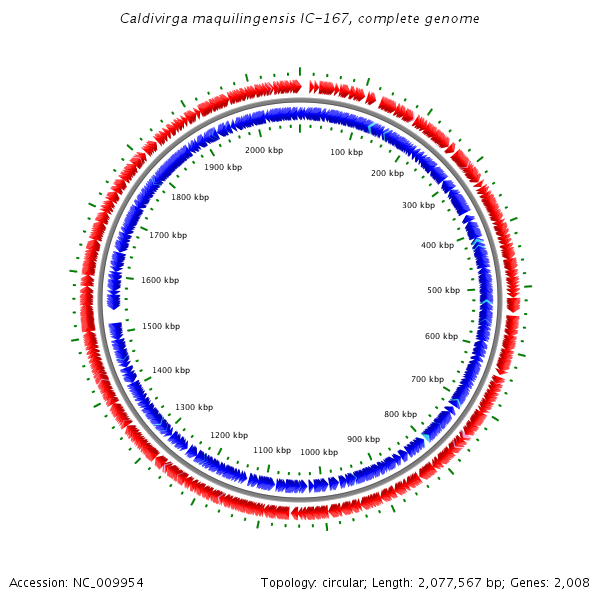Caldivirga maquilingensis: Difference between revisions
RodriguezG (talk | contribs) |
|||
| Line 37: | Line 37: | ||
[[Image:Bacterial_genome.png|Complete Genome of Cladivirga maquilingens http://wishart.biology.ualberta.ca/BacMap/cgview_linked_maps/NC_009954/1_1.html]] | [[Image:Bacterial_genome.png|Complete Genome of Cladivirga maquilingens http://wishart.biology.ualberta.ca/BacMap/cgview_linked_maps/NC_009954/1_1.html]] | ||
[[Image:Table|number]] | |||
==Cell Structure, Metabolism and Life Cycle== | ==Cell Structure, Metabolism and Life Cycle== | ||
Revision as of 18:03, 13 April 2012
{Uncurated}}
Classification
Domain: Archaea
Phylum: Crenarchaeota
Class: Thermoprotei
Order: Thermoproteales
Family: Thermoproteaceae
Species
|
NCBI: Taxonomy |
Caldivirga maquilingensis
Description and Significance
Describe the appearance, habitat, etc. of the organism, and why you think it is important.
Caldivirga maquilingensis were first isolated from a hot spring located in the Philippines. This hot spring is known as 'mud spring' and is found in Mt. Maquiling, Laguna. This hot spring is extremely acidic. The temperature range for the spring range from 60-92*C. The pH range was from 2.3-6.4. In lab growth, it was determined that C. maquilingensis grew best at 85*C and at a pH range of 3.7-4.2.
The appearance of C. maquilingensis ranges slightly. Most are rod-shaped and are either completely straight or have a slight curve shape. Although, the width of the bacteria range widely, the average size is 0.4-0.7 micrometers.
Identification of new hyperthermophilic archaea would definitely increase the biodiversity of microorganisms. It can also help in characterizing other related species by using its metabolic activity and genome sequences. C. maquilingensis can thereby improve our knowledge of emerging field of research such as other modes of DNA repair, transcription and translation regulation, and origins of life.
Genome Structure
Describe the size and content of the genome. How many chromosomes? Circular or linear? Other interesting features? What is known about its sequence? It has been found that it consist of 2048 genes and 37 pseudogenes. With the 2048 genes, 2000 are protein genes and the rest are RNA genes. The circular genome has a size of 2,077,567 base pairs.
Cell Structure, Metabolism and Life Cycle
Interesting features of cell structure; how it gains energy; what important molecules it produces.
heterotrophs, anaerobically and microaerobically
require sulfur, thiosulfate or sulfate as electron acceptors
isolates grew well in yeast extract (carbon source)
(other sugars worked, but not as well (glycogen, gelatin, etc.))
large amounts of tetraether core lipids and trace amounts of diether core lipids.
Ecology and Pathogenesis
Habitat; symbiosis; biogeochemical significance; contributions to environment.
If relevant, how does this organism cause disease? Human, animal, plant hosts? Virulence factors, as well as patient symptoms.
Caldivirga maquilingensis was found in the acidic hot mud springs near the base of Mt. Maquiling. These springs have a consistant temperature between 70°C and 90°C as well as a consistant pH range of 2.2 - 5.1. So far, there has been no evidence of a symbiosis between C. maquilingensis and other bacterial species, but it was found that Thermoproteus spp. also reside within the same hot spring environment in the Phillipines, which may have some kind of symbiotic relationship that is still unknown. As of right now, there has been no evidence of C. maquilingensis to have any pathogenicity towards any other microbes or humans.
References
http://ijsb.sgmjournals.org/content/49/3/1157.full.pdf+html [This is where I found all the above info, I will properly cite within the next day or two]
Author
Page authored by Katelyn Prieskorn, Elgin Paul Quebral, Mitchel Reed, and Grace Rodriguez, students of Prof. Jay Lennon at Michigan State University.
<-- Do not remove this line-->

